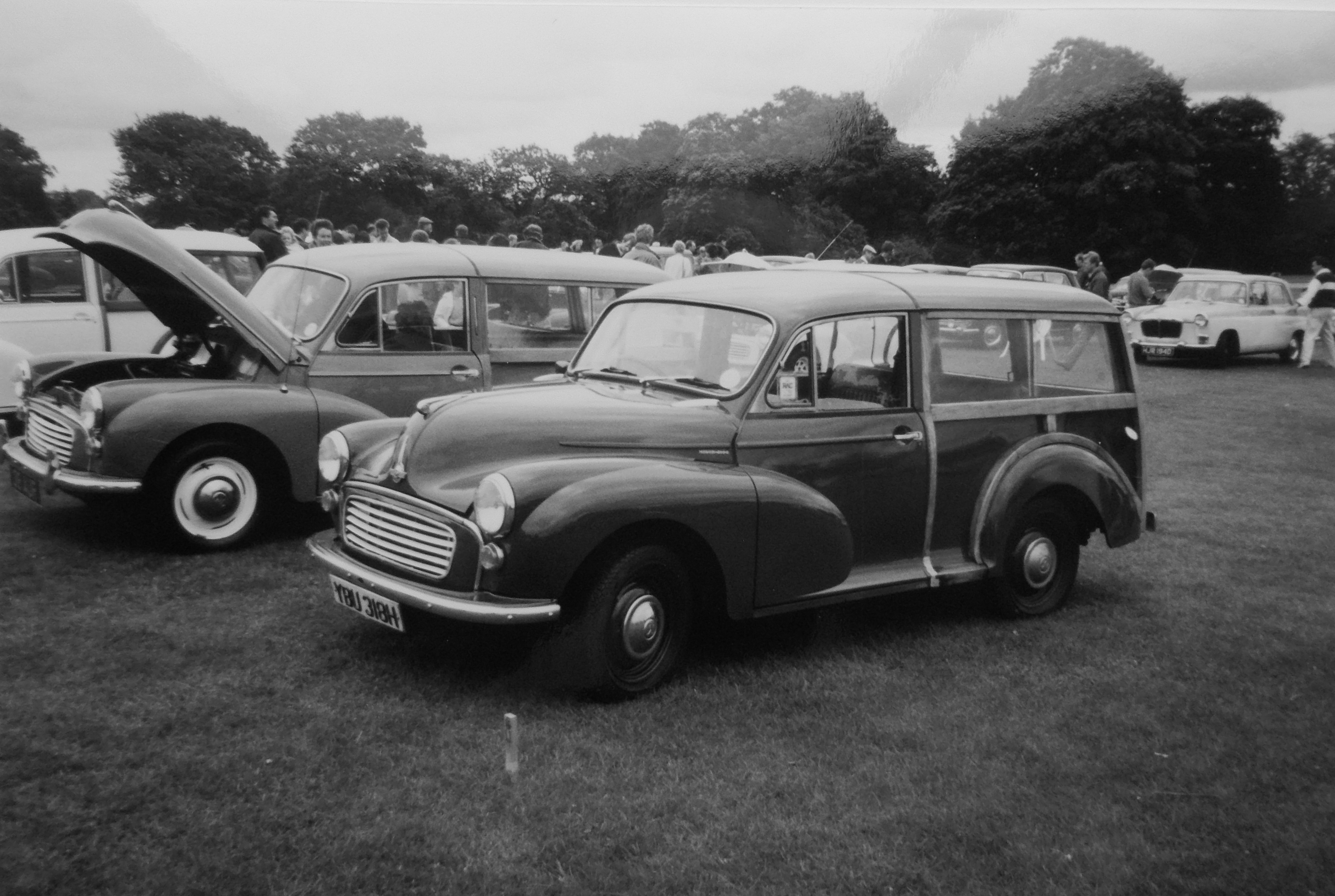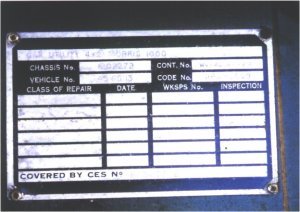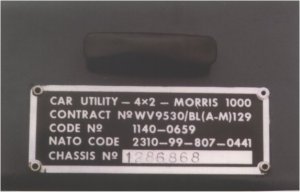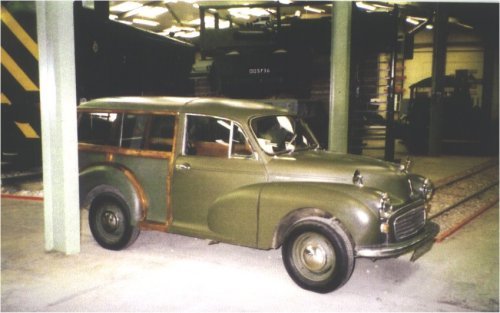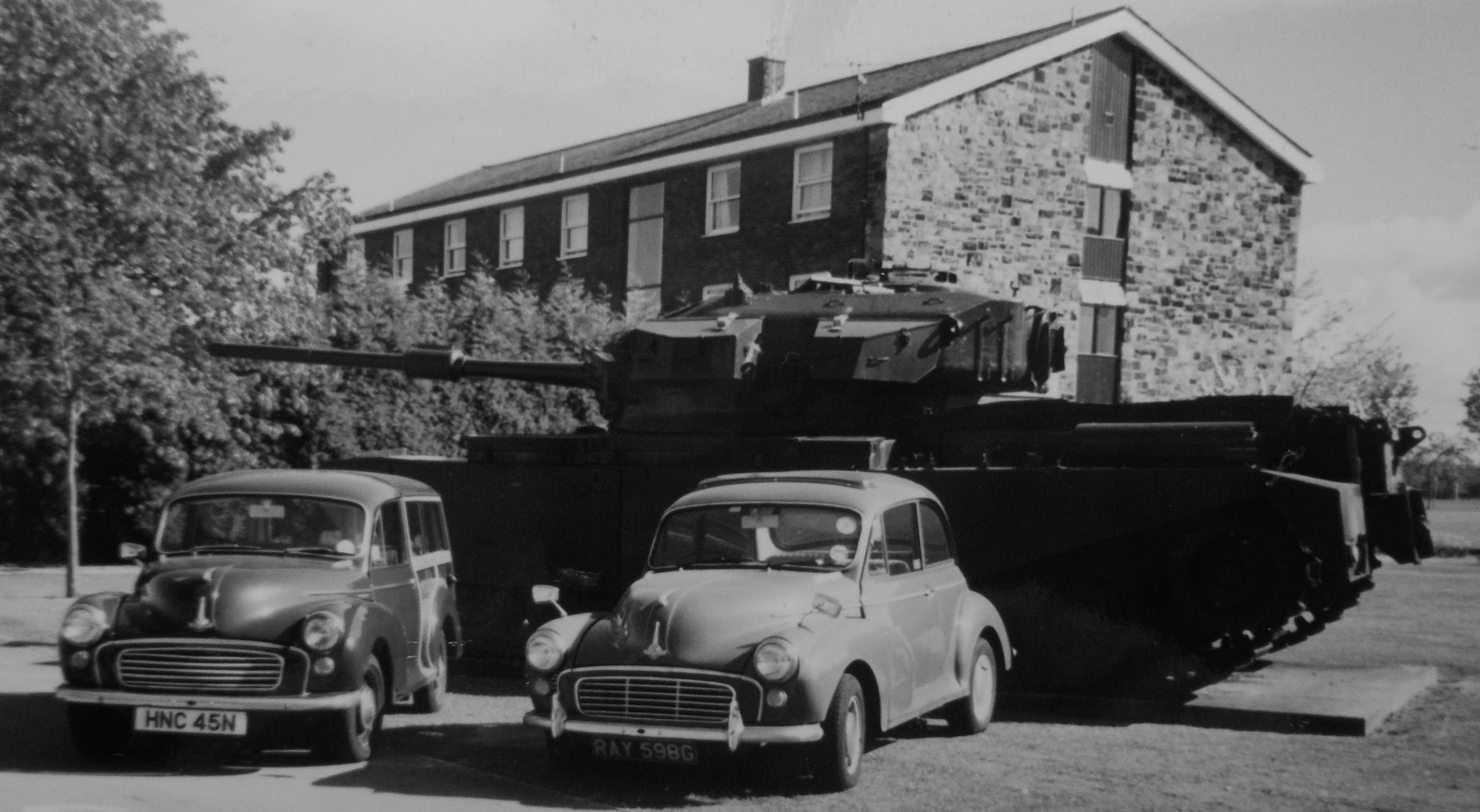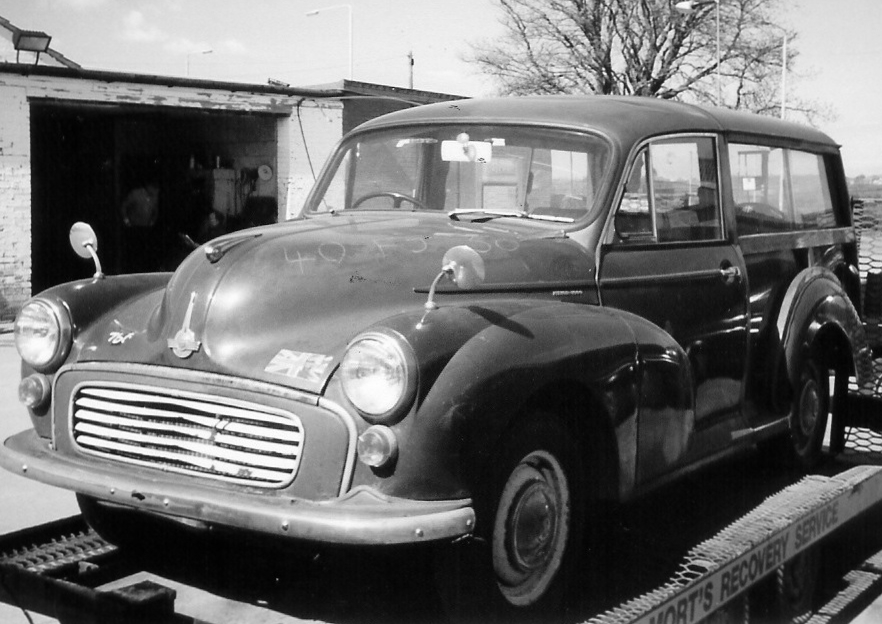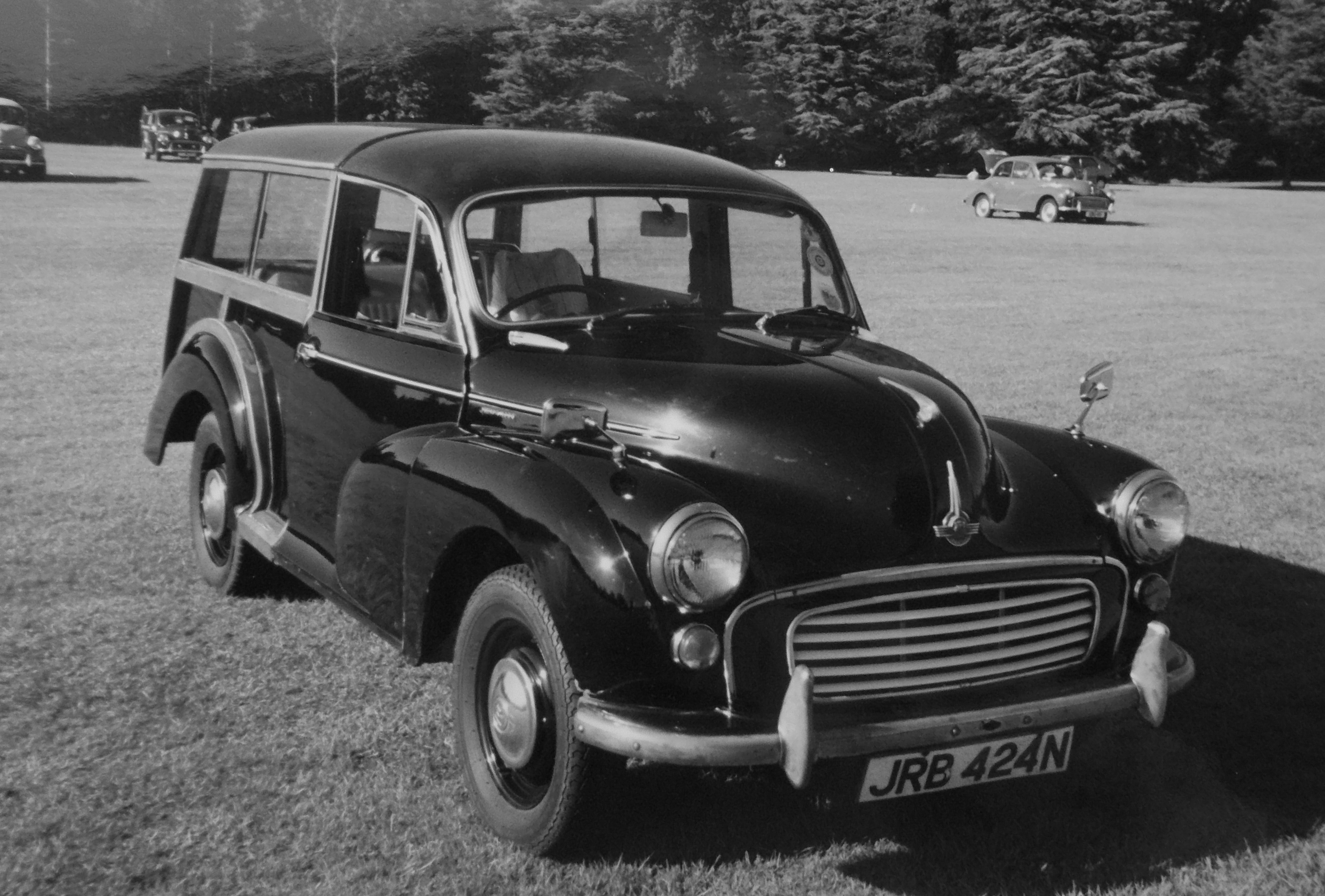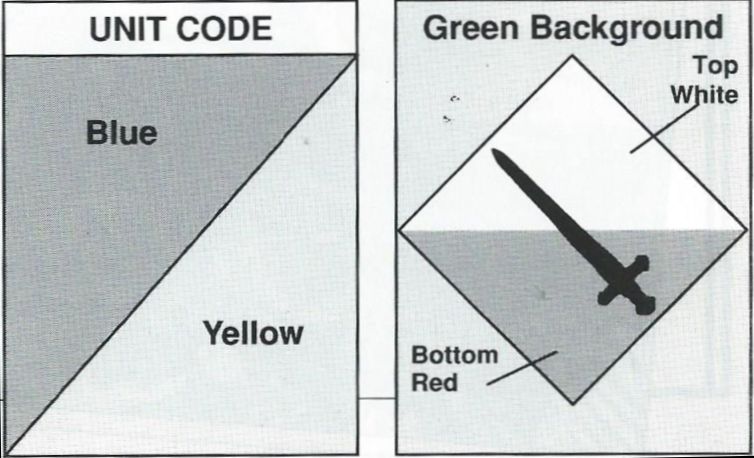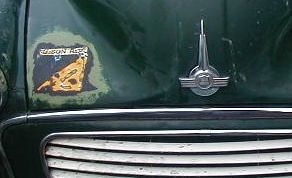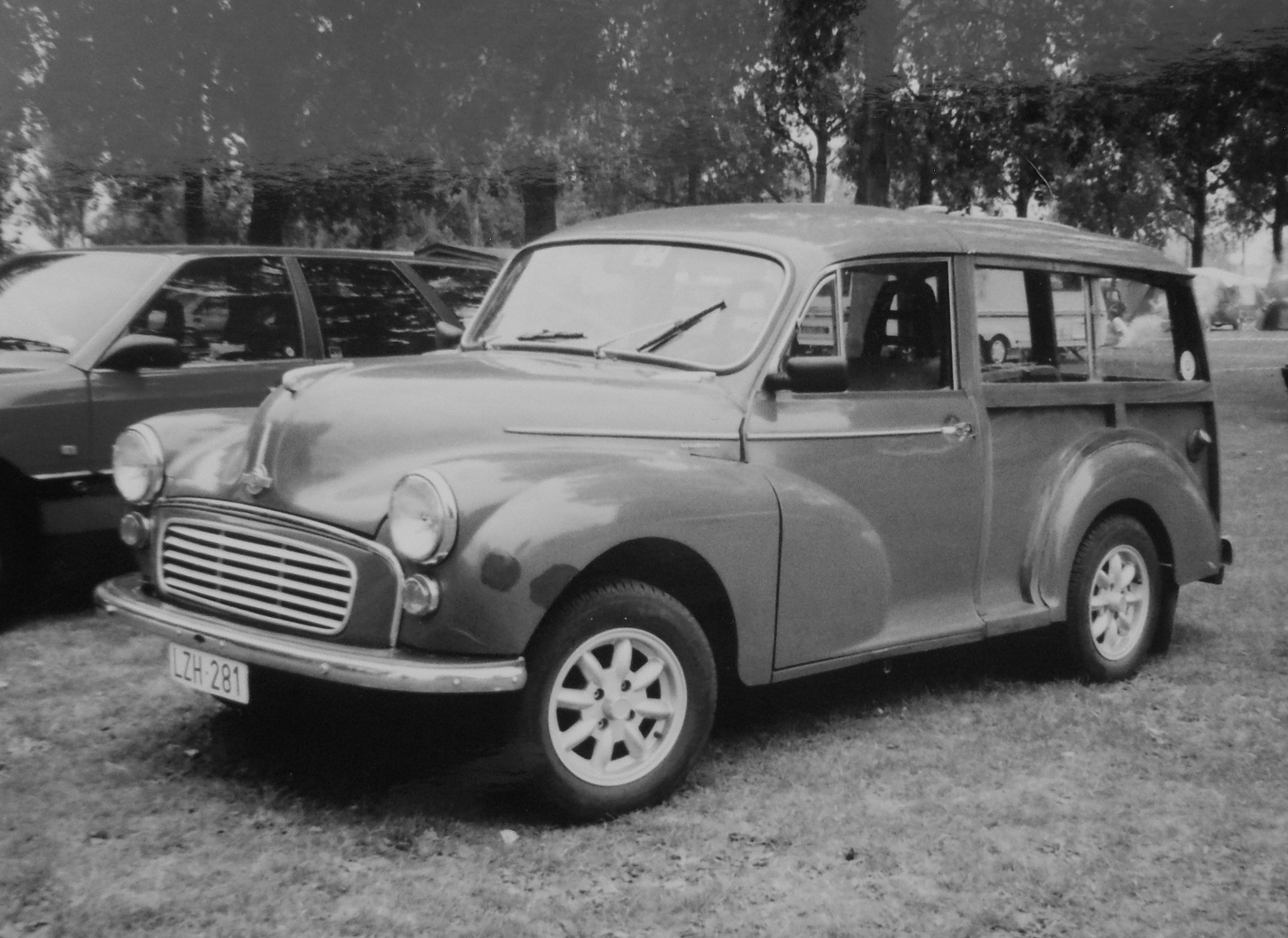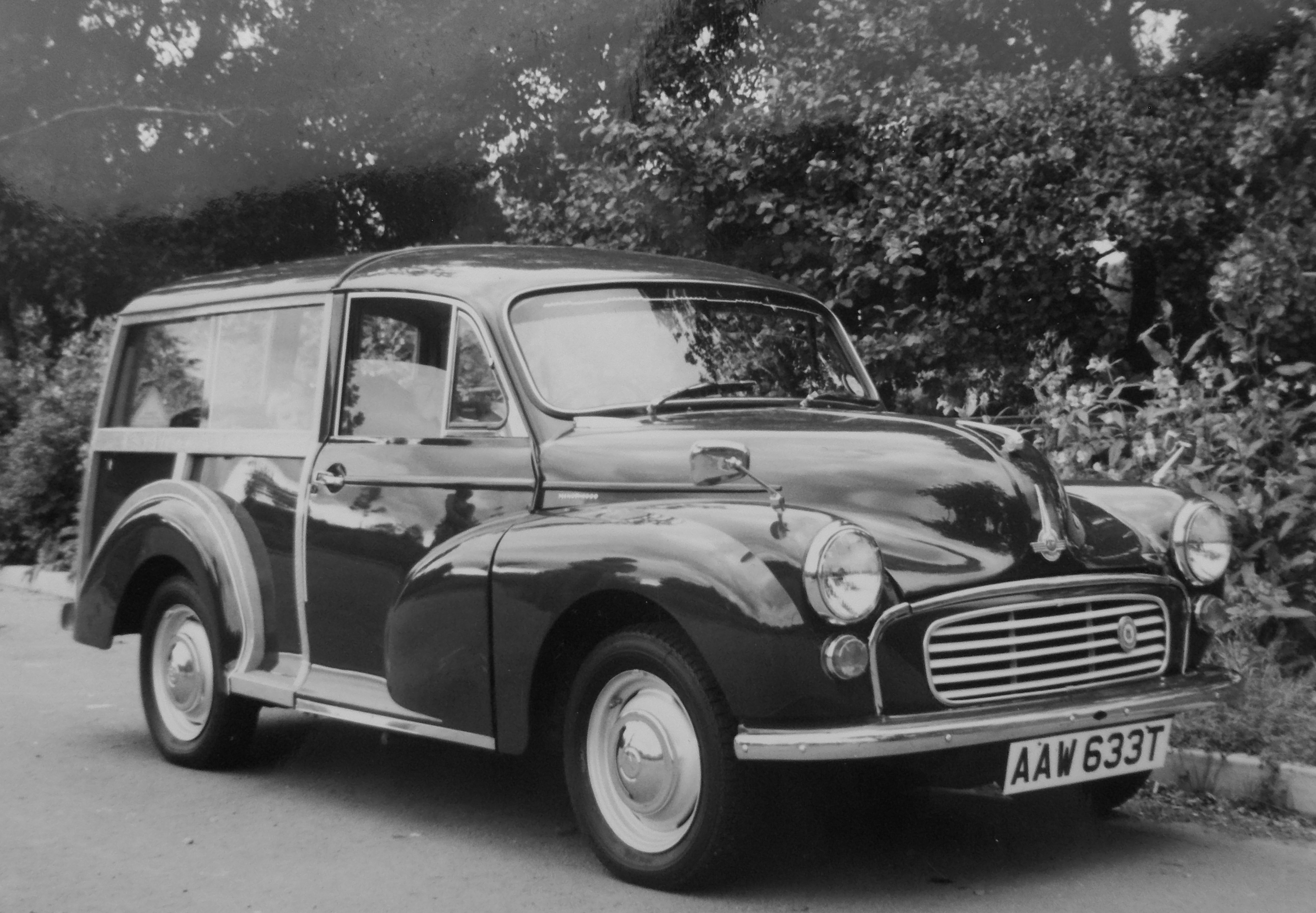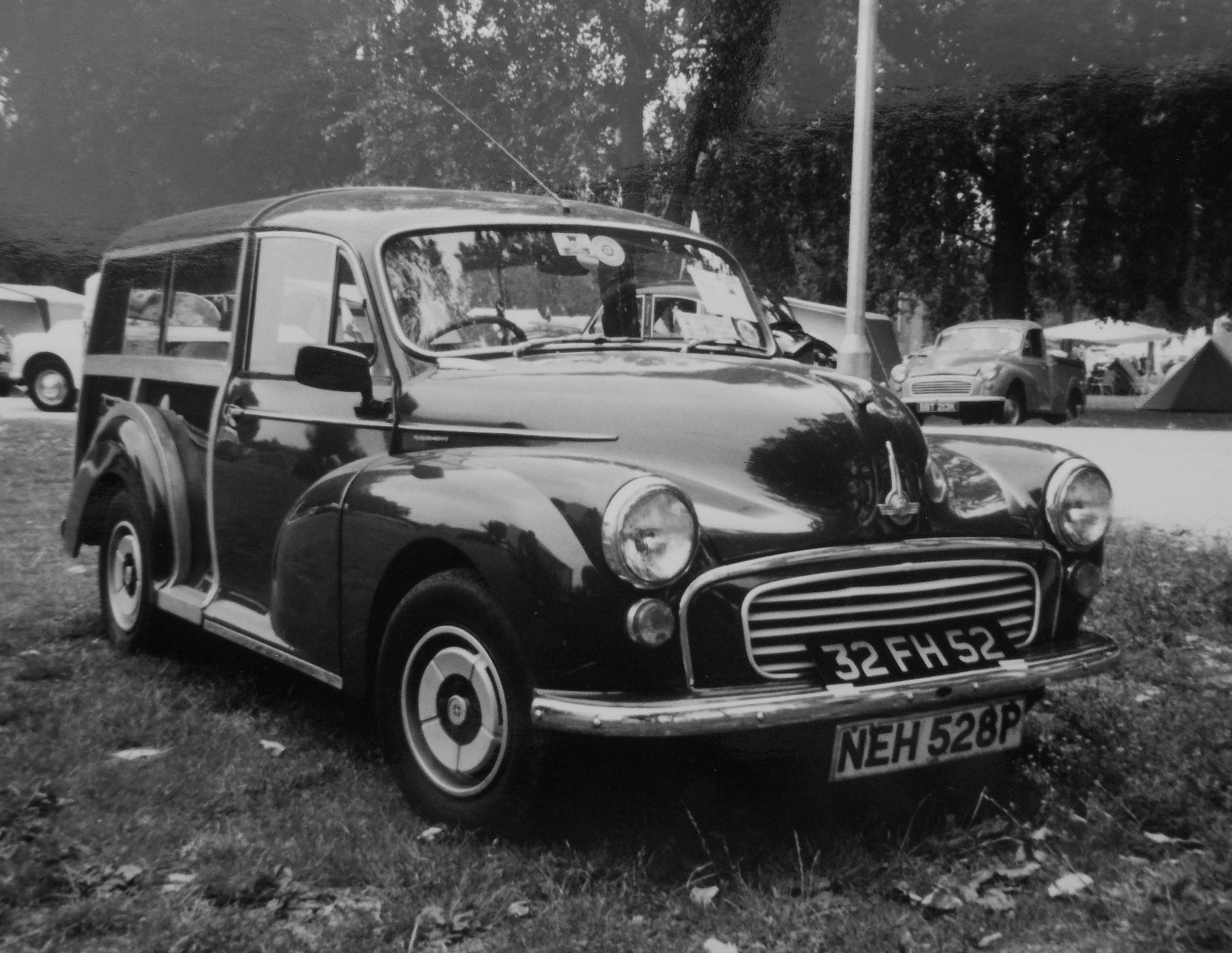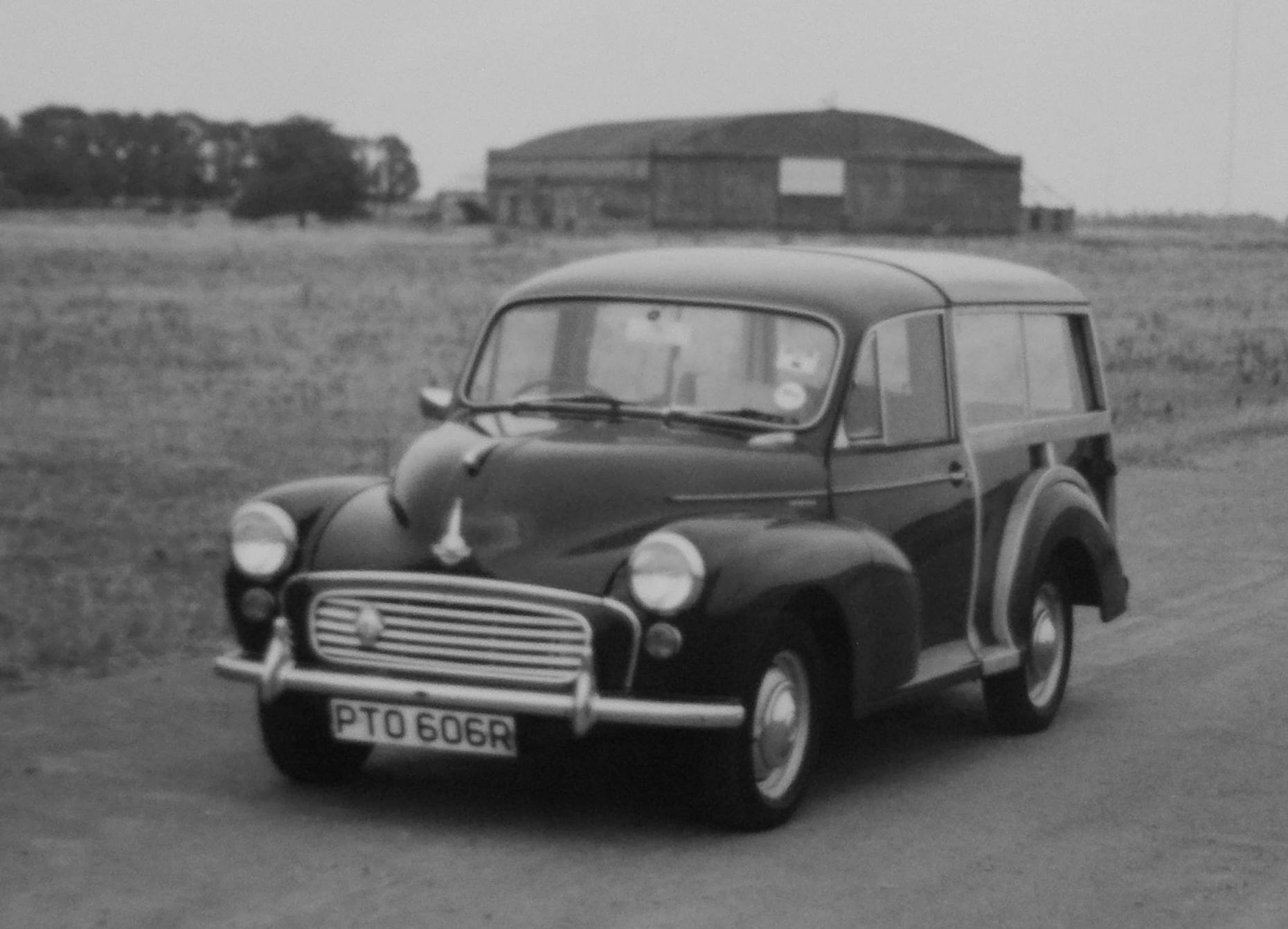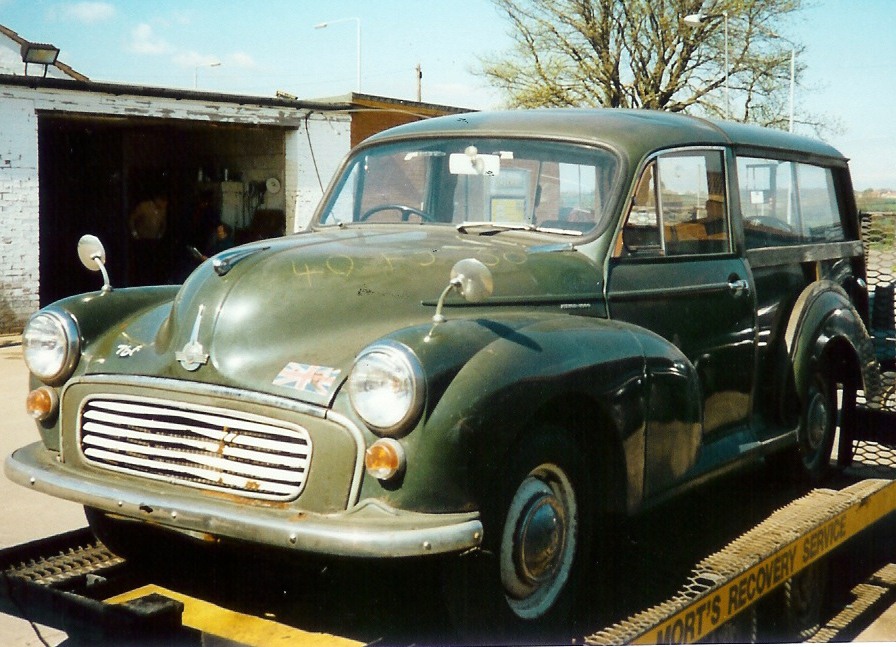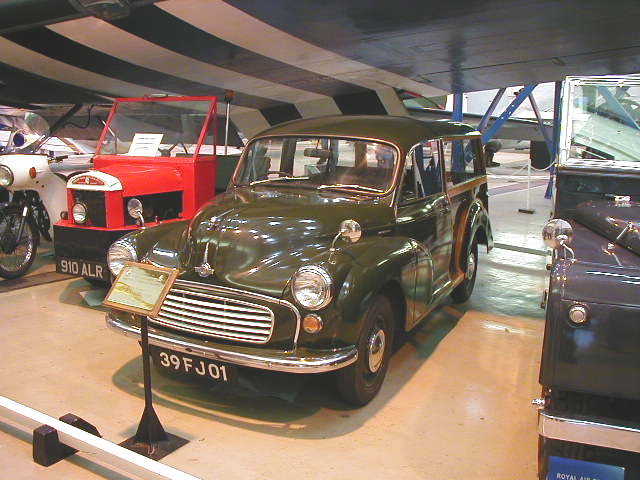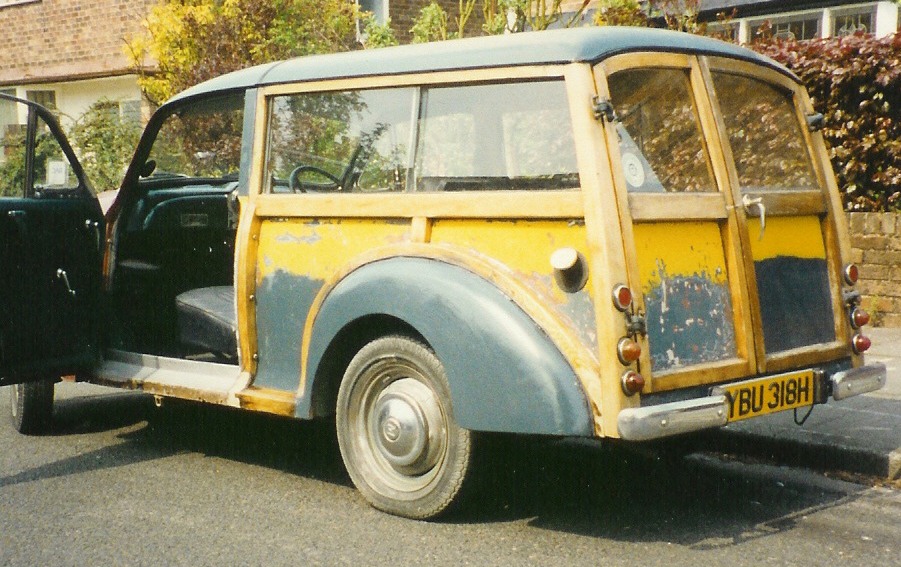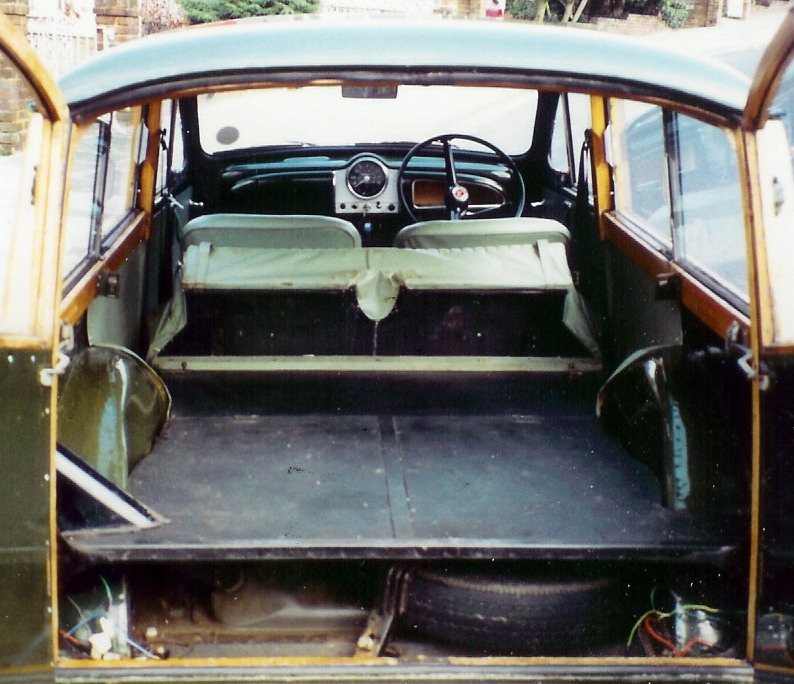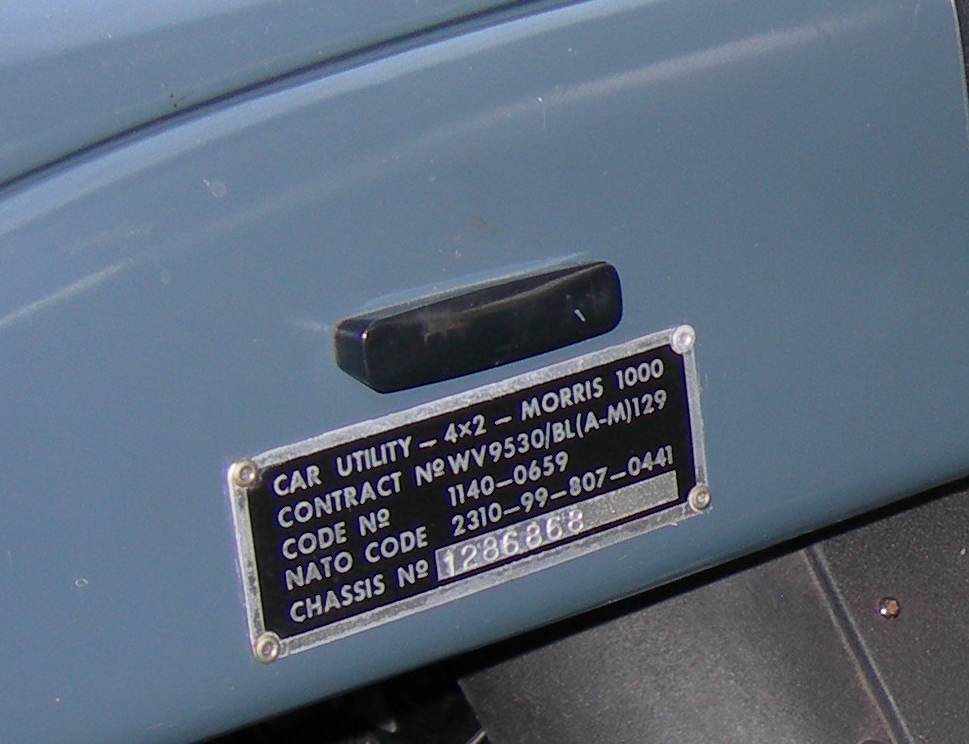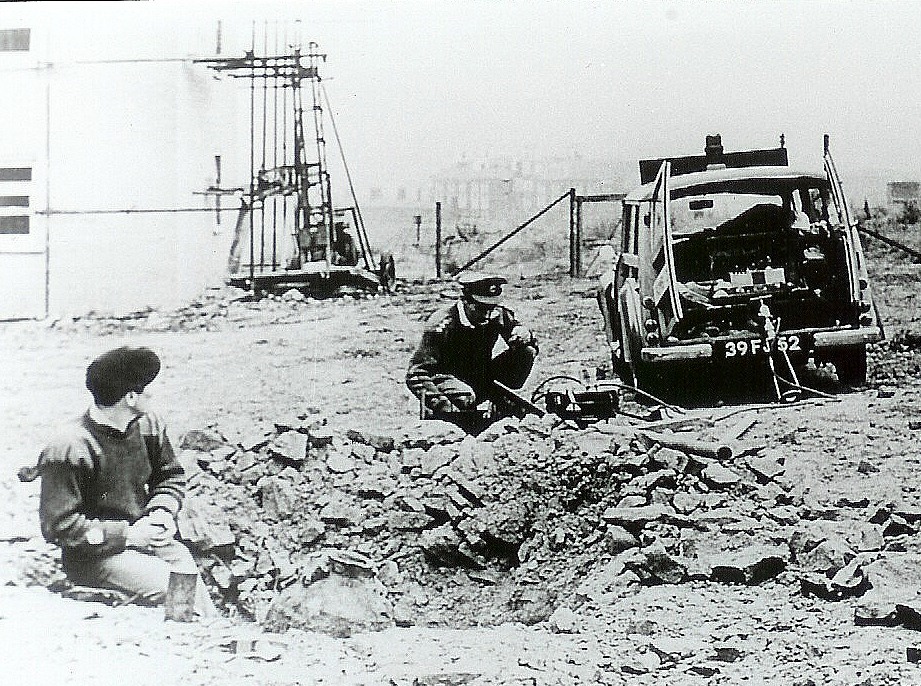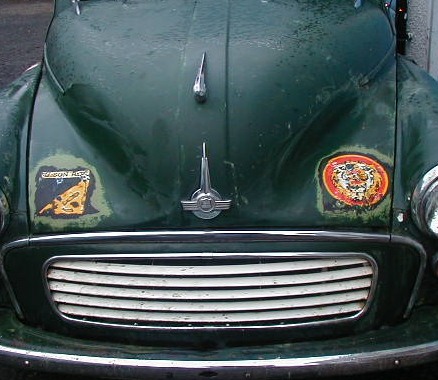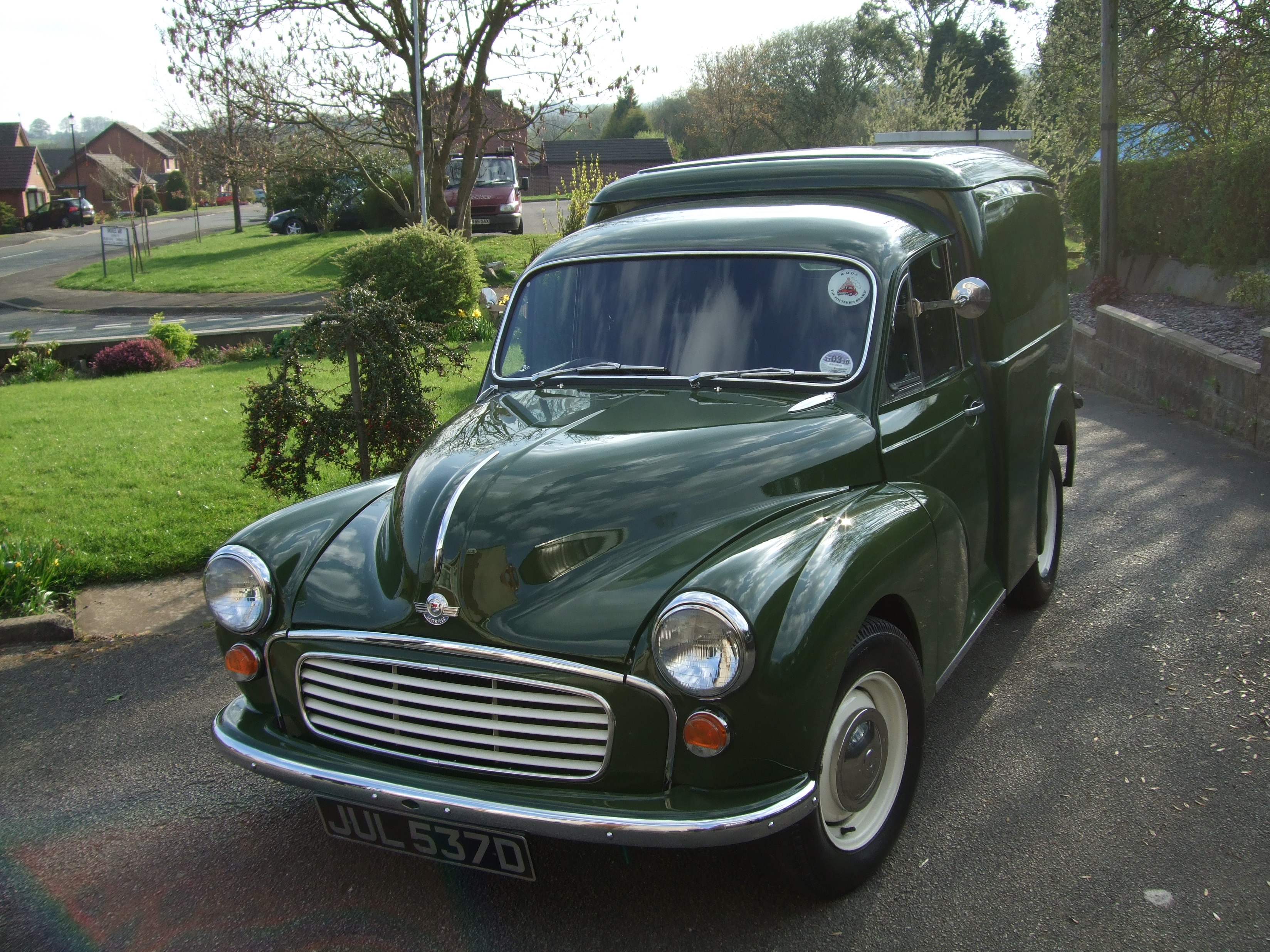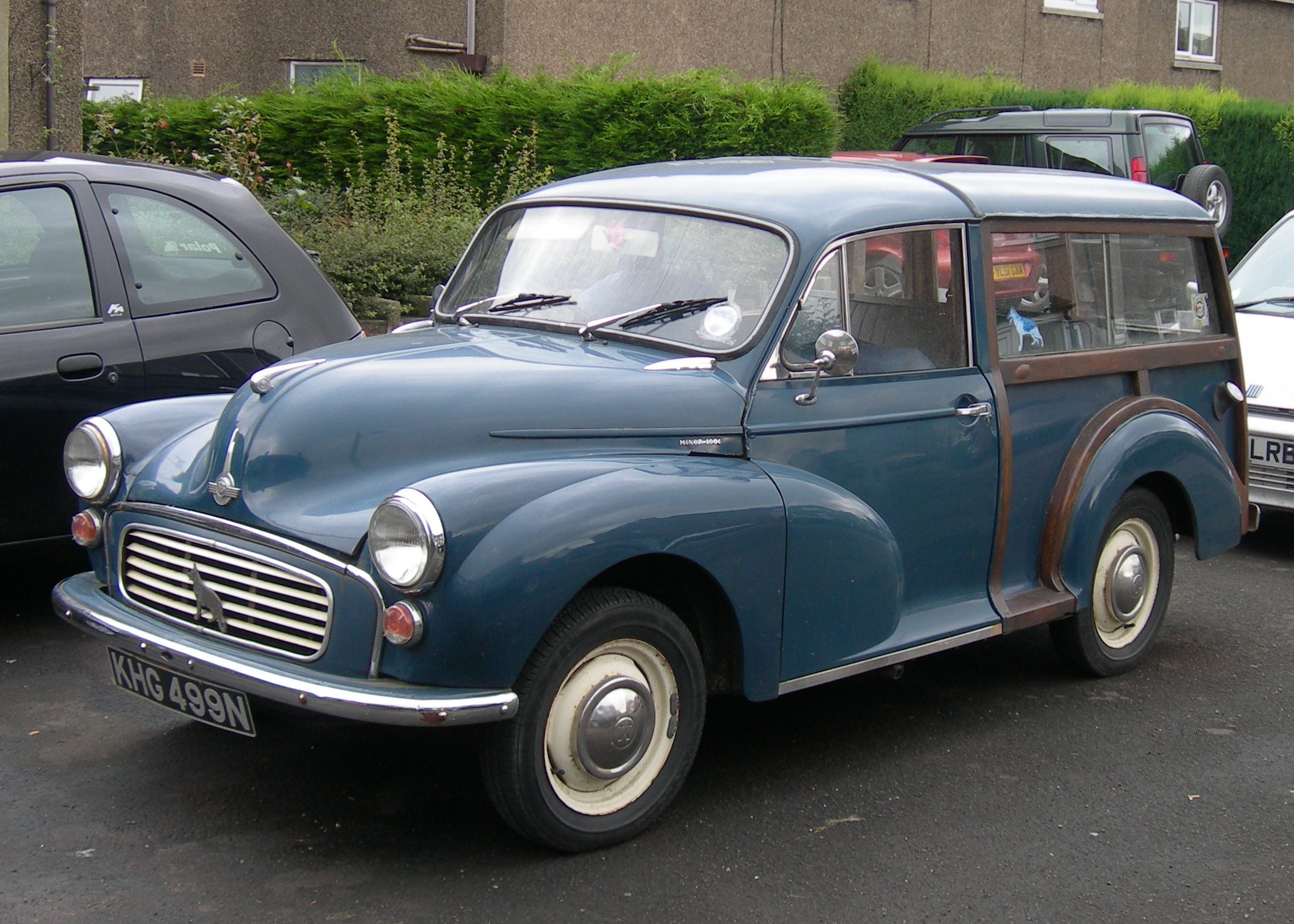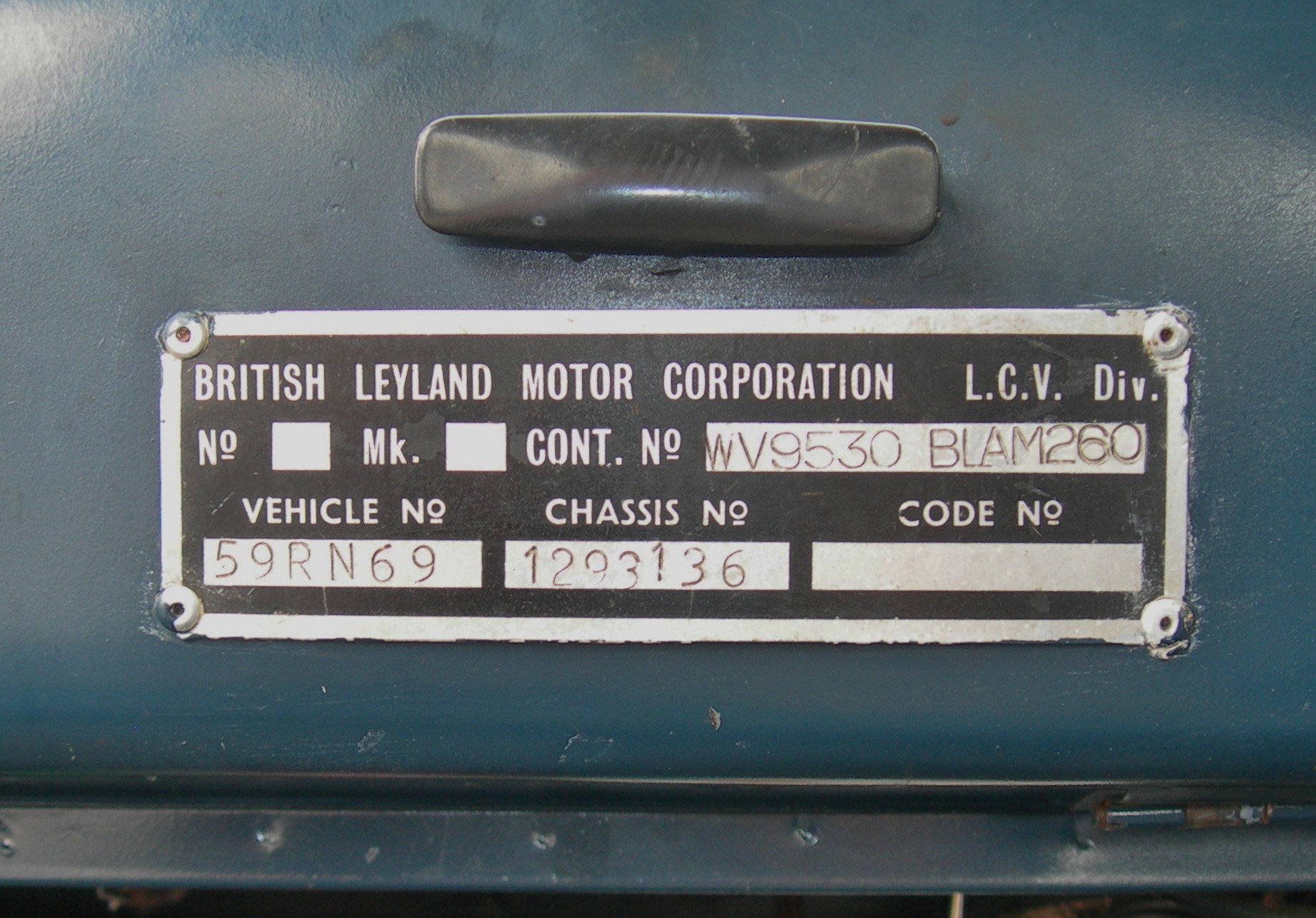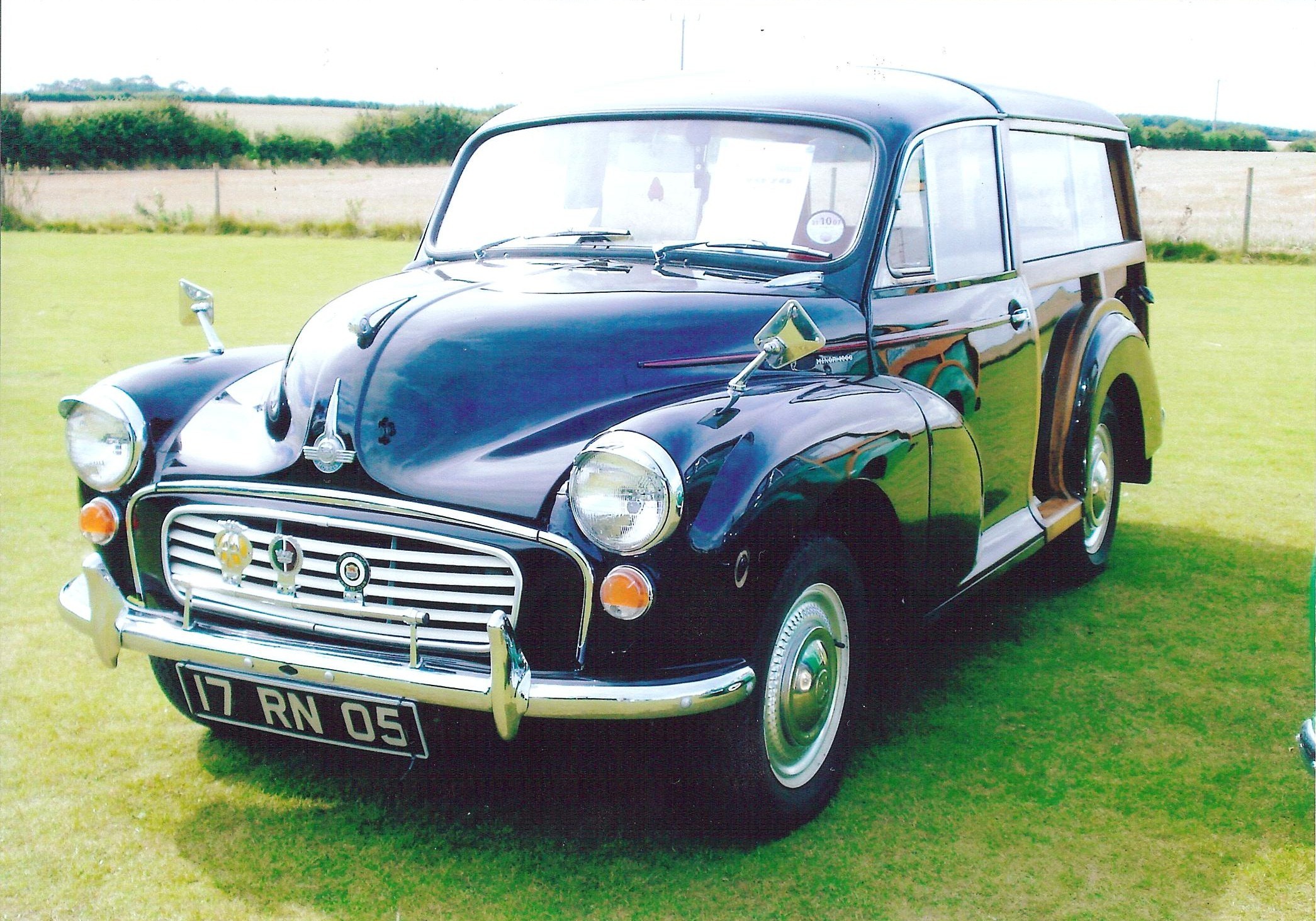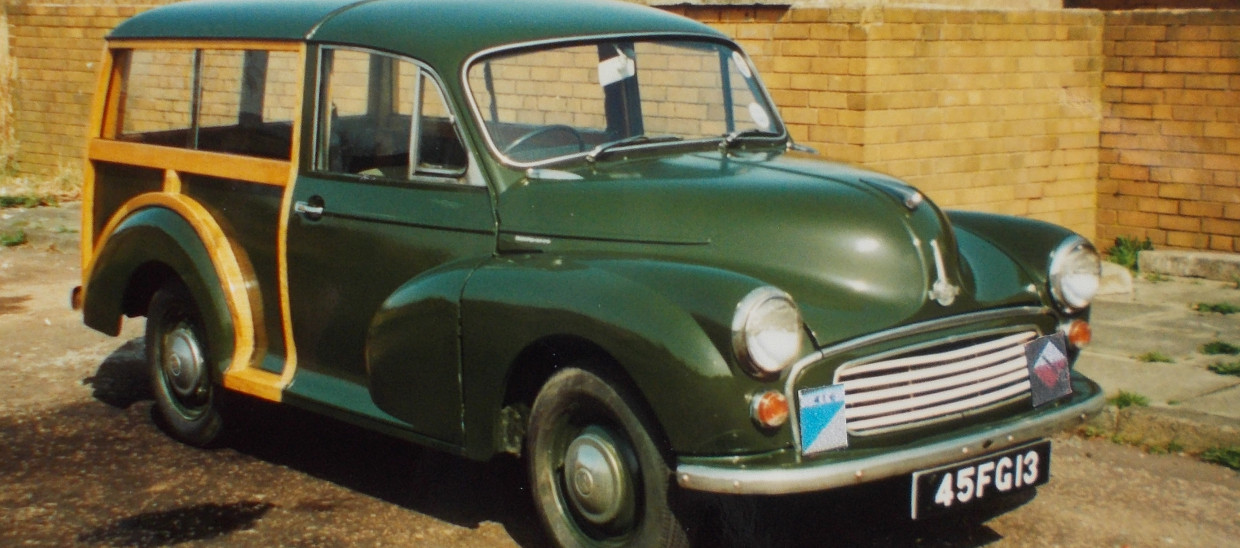

ARTICLES
Click Coloured Tab Titles for published articles
Taken from Minor Matters magazine, March/April 1993
Morris Minors have served the Ministry of Defence at home and abroad for many years. Gerry Cambridge continues the story...
It was in 1965 that my wife and I bought our first Minor. This was a
fairly dilapidated 1953 2 door saloon which conveyed us, together with
our infant daughter (who now runs her own Trafalgar Blue saloon), complete
with cot and pram on the roof and a day’s supply of baby food, etc.,
on our first holiday to Bournemouth. Apart from the fact that the exhaust
pipe fell off half way there, it carried out its duties with flying colours.
After our return we sold it and soon after bought a Series 2 Traveller
which took us safely and reliably all over the country for about ten years.
This was eventually changed for a 1000 Traveller which, in turn, was replaced
by an ex-RAF Traveller from a military vehicle dealer in Manchester in
1985.
It was Bryan Gostling’s article in Minor Matters which aroused our interest in ex-Forces Minors. Having read Bryan’s article I began to do some research, firstly on our own vehicle and then more generally. Recently we have bought an ex-Army Traveller which is also being restored and the idea is to work on one and use the other. The starting point for tracing the history of a vehicle is the military registration number. The MOD uses a distinctive system of registration numbers, started in the early 50s, which is basically the same as the original civilian series of two letters followed by four numbers, except that the letters are placed in the middle of the numbers to avoid confusion, e.g. 39 FJ 39. Morris Minors were all in the FG, FH, FJ, FK, AM and RN series. Unfortunately RAF vehicles do not always have this marked on the Identification Plate. I found the Local Motor Tax Office very helpful here as they gave me a copy of the auction release note giving the registration number and this enabled me eventually to trace the car’s history, via the RAF Museum, Hendon.
The Morris Minor was one of a long succession of civilian type vehicles
used by H.M. Forces as Utility cars or ‘Tillys’. Examples are
pre-war Standards, Morris 10, Hillman Minx, Austin 10 and Hillman Husky.
They were succeeded by Ford Escorts and more recently the Vauxhall Chevette.
It was officially known as “Car Utility 4x2 Morris 1000”. Its
purpose was to “carry 4 persons or 2 persons and a full load of stores”.
The body was described as a “Commercially produced utility with full
width double rear doors, having a folding rear seat to provide a flat
loading platform for the carriage of light stores.” The mechanical
specification is as for the civilian version, except for having a low
compression engine.
Morris Travellers were supplied in bulk to the Ministry of Supply as a
result of contracts placed between 1966 and 1971. About 2000 were supplied
altogether and they were used by all arms of the Services, but the Army
was by far the largest user. They were originally finished in Army bronze
green, RAF blue/grey or Navy blue, though subsequently they were repainted
in the current drab green in the late seventies. Some were painted white
for service in tropical regions. Some had yellow roofs, Navy vehicles
remained blue. The internal finish was fairly basic (qv the article by
Bryan Gostling in Minor Matters Vol. 7 No. 4) e.g. no boot lining, rubber
floor mats and plain door panels. A fire extinguisher was fitted either
to the front nearside scuttle or on the gearbox tunnel in front of the
gear lever. The upholstery and trim was originally porcelain green or
light blue but later black or autumn leaf brown was used. The last batch,
supplied in 1971 for use by the British Army of the Rhine (BAOR) in Germany
were in standard deluxe finish except for an unlined boot floor. Many
of these were used for the Royal Corps of Transport Welfare Pool by civilians
and soldiers and their families at BAOR bases.
They were distributed from Central Vehicle Depots at Hilton, near Derby, Ashchurch, Irvine and Antwerp and were sent to various locations in Great Britain, Germany, Hong Kong, Cyprus, Gibraltar and Malta.
The duties undertaken were mainly of a technical/administrative nature such as Careers Information, Chaplain’s Department, District HQs, Education Service, Cadet Forces, Driver Training and Stationery Distribution and carriage of light goods and as general runabouts and personal transport as well as more specialist roles by Military Police, Bomb Disposal, Mobile Display Teams, various engineering units and Regimental duties and on Airfields. Those used on airfields and other places where visibility is important had a bright yellow band painted round the middle. Many had military formation plates and arm of service plates attached to the front bumper and rear doors.
The earlier batches had chassis numbers which ran in consecutive blocks which were pre-allocated, hence the discrepancy in some cases between the chassis number and year of manufacture. Those made at Adderley Park from 1970 onwards were numbered non-sequentially, interspersed with civilian vehicles. As we know, there are no records of the activities at Adderley Park, so it is not possible to find out why this happened except to guess that chassis numbers were allocated at random as the vehicle left the assembly line, or that a system of batch production was used as suggested by Paul Skilleter in the latest edition of his book “Morris Minor”. The first known vehicle was chassis number 1191002 and was supplied in January 1968 and the last was number 1293790, supplied in June 1971.
It would appear from Order Ledgers at Beverley Military Transport Museum,
that some cars were also ordered but no details as yet can be traced of
any of these. It also appears that contracts were placed between 1959
and 1963 but again no details of any of these has emerged.
Military Minors were sold, together with other Government Surplus vehicles,
at auctions at the Royal Army Ordnance Corps’ Ordnance Storage and
Disposal Depot at Ruddington, near Nottingham, apparently when the vehicle
fell below a certain Reliability Classification. These auctions were held
about four times a year from 1947 till 1983 when the Ministry of Defence
closed this part of the Depot down. It is remembered with fondness by
many Dealers and members of the public who did business there. The last
Minor taken out of service was in 1980 and the last sold to the public
in about 1985/6. Until then military vehicle dealers were a source of
often good quality vehicles.
Morris Minors (cars, Travellers and LCVs) were also used in large quantities by other Government Departments, e.g. Department of the Environment, Customs and Excise, Home Office, Royal Ordnance, D.H.S.S., Department of Employment. These were also disposed of at Ruddington.
Record cards giving details of service history for M.O.D. vehicles are
kept at the Museum of Army Transport, Beverley, Humberside and the R.A.F.
Museum at Hendon and copies will be provided on application and payment
of a fee. Records for nearly all Minors, except Navy vehicles, are available.
The fact that these cards have survived is a lucky chance as they were
supposed to have been destroyed but for someone’s foresight in realising
their potential value and deciding to keep them. Many researchers and
owners of ex-Military vehicles are grateful for this.
There is still much to be done. I should like to trace the contracts for
cars and also contracts placed before 1966. I also want information about
Royal Navy Minors as no records for these have yet appeared, though some
Navy records are slowly coming through to Beverley. If any member has
a vehicle which falls into any of these categories I should be pleased
to hear about it. Also, if anyone has any further information about Minors
used by other Government Departments I should be glad to have it.
Robin Taylor of the Road Transport Fleet Data Society is interested in the existence and whereabouts of Morris Minor cars, Travellers and LCVs which were used or supplied by various Government Agencies and Public Services and Utilities, e.g. DHSS, GPO, Police and Electricity Boards, etc. He would like photos and details of such vehicles and can be contacted at 97 Thorpe Road, Norwich. We are hoping eventually to compile a list of all Government Service Minors. He may also have information of interest to our members.
I acknowledge information and/or photographs from the following:
- Robin Taylor, Road Transport Fleet Data Society.
- British Motor Industry Heritage Trust.
- Museum of Army Transport, Flemingate, Beverley, Humberside.
- Battle of Britain Prints International Ltd (Wheels and Tracks), Church House, Church Street, London.
- Bryan Gostling, Minor Matters.
- Various Club Members who responded to my request for information in a previous issue of ‘Minor Matters’.
Gerry Cambridge
Footnote:
We would like to create a Register for all ex-Government Service Minors,
so that information and details about them can be gathered for research
and mutual interest.
How can such a vehicle be identified? They usually have distinguishing features such as Identity or Government property plates, sometimes there are mysterious knobs and switches which have no purpose. In the case of ex-MOD vehicles, of course, the year suffix letter will be from M to Y or in a few cases Q as these were only given a civilian registration after “demob”. So if you have such a vehicle or know the whereabouts of one, please contact me with details at gerry.cambridge@mmoc.org.uk
The success of Gerry Cambridge’s last article on Military Minors (Minors on Her Majesty’s Service) prompted a great response from MMOC members. In the wake of the VE day celebrations, this second installment continues the story of those Minors who "Got Some In"!
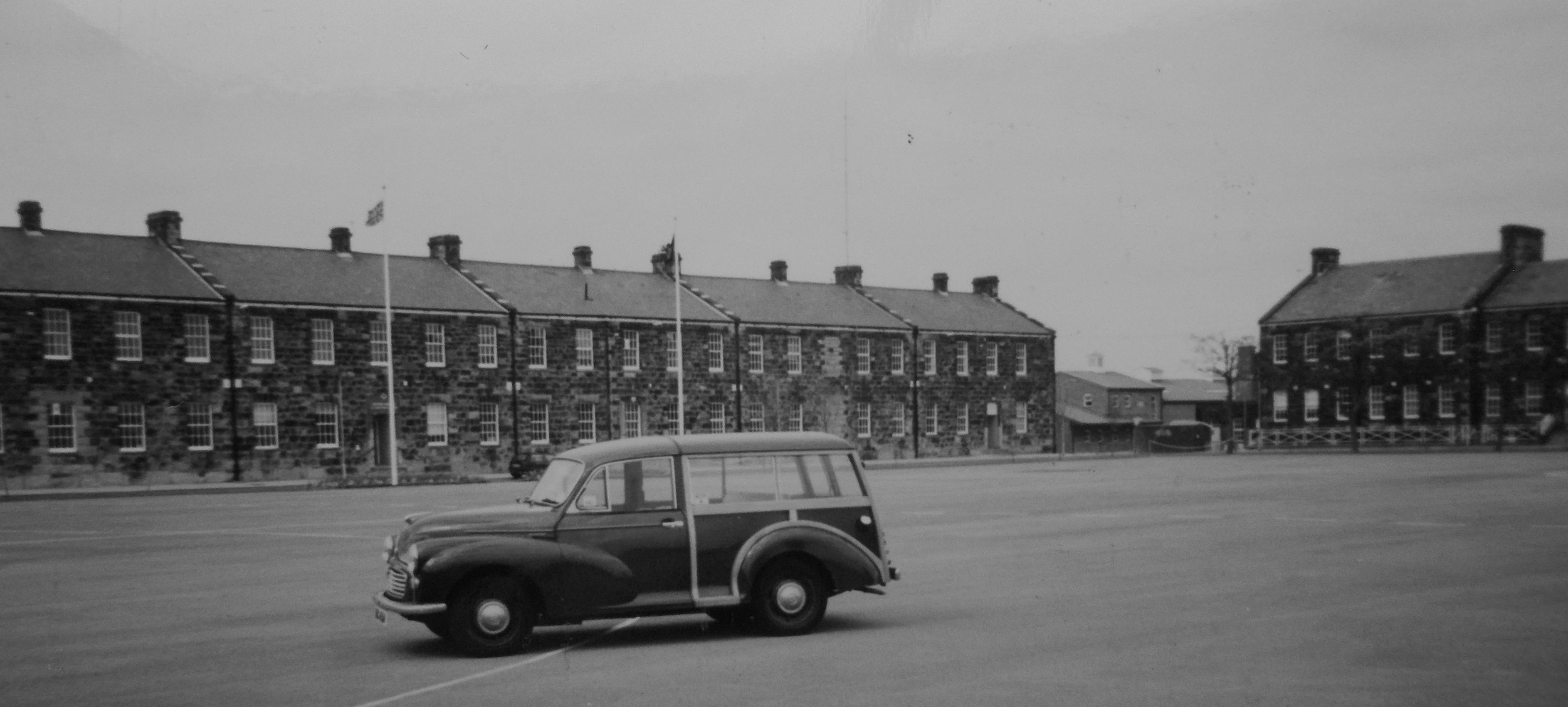 Army Minor on Parade Ground
Army Minor on Parade GroundThe Morris Traveller, as well as being an accepted and established classic car, is also an interesting military vehicle in its own right. Travellers were used by the Armed Forces during the 70s in much the same way as Land Rovers today – as general runabouts and also for many specialist purposes as is shown by the picture of the Bomb Disposal vehicle on “active service” defusing a wartime German bomb. Not many pictures of Travellers in service have come to light as soldiers are not in the habit of taking photos of their vehicles whilst they are in use. Land Rover owners seem to be more fortunate in this respect.
It may be interesting to look at some of the ways that military Travellers can be restored to their original condition. As mentioned in my previous article (Vol. XIV No. 5) Travellers were used by all three services and painted accordingly, i.e. deep bronze green (Code BSC 224) for the Army, blue/grey (BSC 633) for the RAF and navy blue or black for the Royal Navy. Later they were overpainted in matt mid olive green. Some had specialist colour schemes added, e.g. yellow for use on airfields, white for the Tropics, red wings for Bomb Disposal, etc., and some Staff cars were black. Initially the internal finish was very basic (see earlier article) but later examples were to standard deluxe finish. At Unit level the grille and wheels were often painted body colour. The Data Plate is usually still attached and this gives details such as the Contract Number and the MOD registration number, essential for tracing the vehicle’s history. Mechanical overhauls had often been carried out and this is indicated by the engine, clutch and gearbox having been painted duck egg blue. A small plate was affixed to the rocker cover giving details and also the appropriate REME Workshop number.
Most Army and RAF Travellers had a fire extinguisher fitted and most seem to have been sold to the civilian market with the holder still in place. Extinguishers and the holder can sometimes be obtained from military vehicle or government surplus dealers. During the time our vehicles were in service, pictorial markings were still being used. These were attached to the front bumper and resulting fixing holes. There may also be the remains of transfers. There were usually two insignia or “tac signs”. One of these indicated the arm of service and the unit and was usually attached to the offside of the vehicle. This would often be Royal Corps of Transport as this corps provides vehicles for other users. The other, showing the formation, was fitted on the nearside. Two examples of such signs are shown. In addition, a National Flag (Union Jack) was sometimes attached to identify NATO forces.
In order to find out more about your vehicle, it is often helpful to write to or visit the Regimental Museum or establishment at which it was based. I found the military personnel at Fulwood Barracks, Preston, extremely helpful and co-operative in giving me information about our own Traveller, which had been stationed there from 1968 to 1975. As, for instance, pictorial markings went out of use so long ago, it is often a matter of coming across someone who was around at the time and who remembers the details. It is also well worthwhile turning up with your car as this will often stimulate interest.
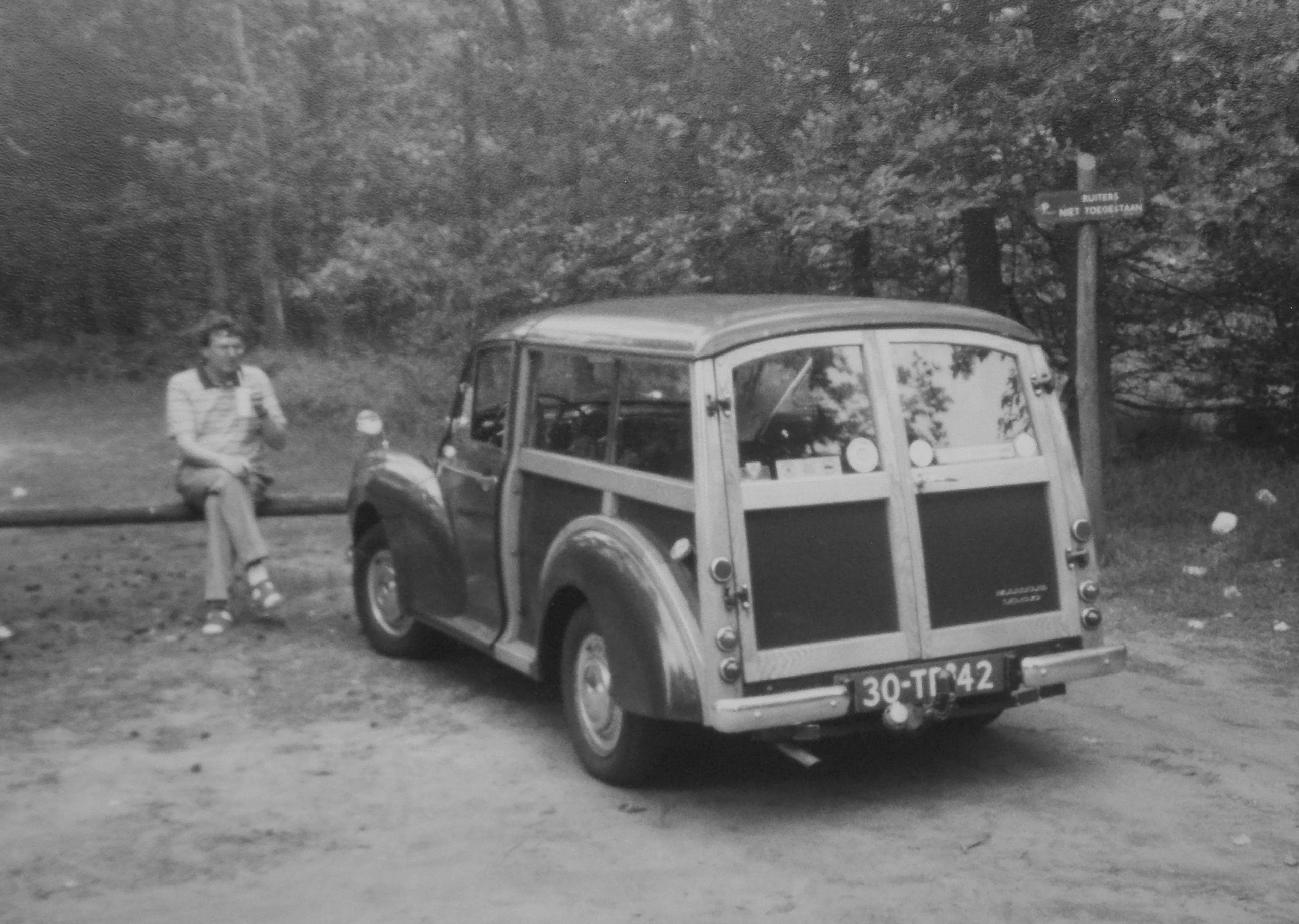 Mr Anton Visser’s Dutch Traveller (42 FJ 69) was featured in the January 1986 issue of Minor Matters
and is one of a large number of similar vehicles used at BAOR bases in West Germany.
This much travelled car is often to be seen at rallies in this country.
Notice that its Dutch civilian mark has the same format as our military serials
Mr Anton Visser’s Dutch Traveller (42 FJ 69) was featured in the January 1986 issue of Minor Matters
and is one of a large number of similar vehicles used at BAOR bases in West Germany.
This much travelled car is often to be seen at rallies in this country.
Notice that its Dutch civilian mark has the same format as our military serialsRoyal Navy Travellers appear to have been procured to a standard civilian specification. The serial numbers of Navy vehicles are re-used unlike those of the Army and the RAF, and despite my exhaustive research, there is no evidence that data cards for Royal Navy Minors have been retained and so no information about a particular vehicle is available. Navy vehicles were used as patrol cars by Provost Marshalls and Naval Police at dockyards. They were also used as staff cars by senior staff of aircraft carriers and were apparently taken aboard and used as runabouts wherever the ship docked. One wonders just which far flung corners of the world they visited!
Finally, to summarise: The number of Travellers in military service was: 2048 vehicles accounted for, of which 1776 were with the Army and of these 746 were left hand drive and went to BAOR in Germany. 217 were used by the RAF of which 81 were sent to Cyprus. The Royal Navy had 55.
As mentioned in the previous article (Vol. XIV No. 5) the data cards are available from the Museum of Army Transport at Beverley or the RAF Museum, Hendon.
I am grateful to fellow members of the Owners’ Club for sending me information and pictures of their vehicles, many of which are featured here.
I will still be glad to receive details about Morris Minors used by any Government department, so that a more complete picture of their use can be developed, so if anyone has any further information, please let me know.
Gerry Cambridge
MMOC Ex-Government Minors Register
I acknowledge help and information from the following
- Museum of Army Transport, Flemingate, Beverley, Humberside.
- Royal Air Force Museum, Hendon, London.
- Major A.S. Hogben, QGM, Explosive Ordnance Disposal Technical Information Centre, Rochester, Kent.
- Major Mike Glover, Queen’s Lancashire Regiment Museum, Fulwood Barracks, Preston.
- Mr. Steve Lowe (Warrant Officer, Retd.) Formerly I/C M.T. Section Fulwood Barracks, Preston.
- Mr. A.C. Sprason, DMS, Royal Regiment of Fusiliers Museum, Wellington Barracks, Bury.
- DVLC Swansea.
- Lesley & David Price (MMOC members).
- Members who supplied infor-mation and/or photos.
Further reading:
- British Army Transport and Logistics, Swann and Fletcher (Ian Allan).
- Formation Badges of World War Two, Lt. Col. Howard Cole (Arms and Armour Press).
- Minor Matters, Vol. VII No. 4 and Vol. XIV No. 5.
In its heyday, the Morris Minor was the vehicle of choice for a range of Government functions. Gerry Cambridge, MMOC Ex Government Fleet Registrar, gives an insight into their history and use.
Published in Minor Matters Magazine - November 2011
Morris Minors (cars, Travellers and LCVs) have been used by many Government Agencies, e.g. Ministry of Defence, Department of the Environment/Property Services Agency, Customs and Excise, Home Office, Royal Ordnance, Department of Employment, Ministry of Agriculture Fisheries and Food, Forestry Commission and D.H.S.S. (these being specially adapted for use by the disabled). Some of you may own such a vehicle and may or may not be aware of its previous 'life'.
MMOC Ex-Government Fleet Register
The Register and website were created as a resource for the benefit of members generally and in particular, owners of Ex government vehicles. We are happy to discuss vehicles and to receive photos and information. New information is always welcome so that existing knowledge can be added to or corrected. We can provide details of colour schemes and fittings to help with restoration. We can also confirm the identity of vehicles (particularly ex-Forces) as we have the chassis numbers of most of these. The website is: govminors.mmoc.org.uk
Identifying features of an Ex Government Minor
- Data plate on the bulkhead under the bonnet or on the glove-locker lid.
- No bumper overriders and possibly holes on the bumper valence and rear doors where badges were fitted.
- Rectangular reflectors under rear bumpers.
- Moulded rubber floor mat. Also plain door panels and no armrests on rear seats. No covering on boot floor.
- Fire extinguisher bracket (and extinguisher), usually on LHS under parcel tray in front of door.
- Non standard colours eg, Blue/ grey, Bronze green, Bermuda blue (similar to Police Panda Patrol cars)
- Post production year identifying letters. (i.e. N through to Y and in some cases Q)
- Traces of original signage (Possibly under the current paintwork)
- Low-compression engines were usually fitted and after overhaul were painted duck egg blue. A workshop plate giving overhaul details was often attached to the rocker cover.
- Non standard front seat runners and indications of modifications for disabled users.
HM Forces used Travellers as utility vehicles and general 'runabouts.' Officially known as "Car Utility 4x2 Morris 1000", its purpose was "to carry 4 persons or 2 persons and a full load of stores". The body was described as a "commercially produced utility with full width double rear doors, having a folding rear seat to provide a loading platform for the carriage of light stores".
Morris 1000 Travellers were first used by the MOD in 1961, major contracts being supplied from1966 until 1971. About 2000 were supplied in altogether and they were used by all branches of the Services, but the Army had the most. They were originally finished in Army mid bronze green, RAF blue grey, and black for the Royal Navy. In the late seventies they were often overpainted in 'drab green.' Royal Navy vehicles remained black. Some were painted white for service in tropical regions. Those to be used on airfields were marked out in high visibility yellow. On Bomb disposal Travellers, all four wings were painted Signal Red. The internal finish was fairly basic, eg a rubber mat instead of carpet. Standard civilian colours were used for upholstery and internal trim. The dashboard was standard, apart from additional switches for auxiliary lights and other devices. Later contracts had standard civilian internal finish. On leaving the factory, they were stored at Royal Army Ordnance Corps Central Vehicle Depots until needed and then sent to the relevant Operational Unit. Many went to Germany (BAOR) and some to Cyprus. Their work was mainly administrative and technical. eg. personal transport for Careers and Recruiting Officers, Chaplains' Pool, District HQ staff and Mobile Display Team support staff. They were used for specialist roles by Military Police, Bomb Disposal, SAS, various Engineering units and aircraft servicing and repair teams. They were used for driver training as well as for the carriage and delivery of light goods and as general runabouts at station level. Royal Navy vehicles were used by Naval Police at dockyards and other naval bases and as staff cars by officers and were often taken aboard and used as runabouts wherever the ship docked.
BAOR Travellers (supplied as Left Hand Drive and with steering column ignition locks.) were used by both civilian and military staff of the various Civilian Works Groups at bases in Germany. Those returning to the UK were converted to Right Hand Drive.
Many Travellers wore heraldic formation and arm of service signs. BAOR vehicles, however, displayed the unit number to which they were attached and the Union flag.
Usually after 5 years or about 55,000 miles they were sold, together with other Government Surplus vehicles, by auction at the RAOC's Storage and Disposal Depot at Ruddington, near Nottingham (now redeveloped as Rushcliffe Country Park). The last MoD Traveller was taken out of service in 1980 and all had been released through the auctions by 1986. A substantial number have survived and are still giving reliable service to their proud owners. Many BAOR vehicles were sold in Holland. So far we have accounted for about 130 vehicles but more are appearing as time goes on.
Vehicle history cards are available from the Royal Logistics Corps Museum at Deepcut on payment of a fee. For RAF vehicles contact the RAF Museum at Hendon.
Despite extensive research, no information has come to light about RN vehicles. They were finished in black and seem to have been to civilian de-luxe standard.
DHSS
The D.H.S.S. supplied many Morris Minors (both cars and Travellers) for use by the disabled since 1949. These had various modifications fitted to individual specifications, eg more sturdy and efficient front seat runners to give greater leg room adjustment, manual clutch/accelerator/brake controls and relocated switches. The cars were maintained and replaced after a number of years and eventually disposed of at Ruddington.
Ministry of Supply
The Ministry of Supply (latterly Property Services Agency) maintained all government estate both civil and military. Morris 1000s formed part of the 'small vehicle fleet' and the Government self - drive fleet. They were disposed of at Ruddington after 5 years or 55000 miles, though many were kept for longer as they were so reliable and easy to maintain.
Most Government department and some MOD Minors ran with civilian registrations ( blocks mainly of London serials set aside for corporate organisations e.g. GPO etc )
The origins of these can be traced via DVLA.
Forestry Commission
The Forestry Commission used Minor LCVs as transport vehicles for managers/supervisors to carry out their tasks and also for the delivery of equipment and supplies. Gillian's van (JUL537D) was originally owned by the Forestry Commission at Saville Row, London in 1966. After serving for three years, she was stripped down, rebuilt and would serve another three years before being stripped and rebuilt again before being decommissioned in1972 and sold on into private ownership, probably via the Government Surplus vehicle auctions at Ruddington.
Not much is known about life between then and 1980 when Gillian bought her (without MOT certificate). She was put into roadworthy condition and was used as Gillian and the family's everyday transport. During this time, she was repainted blue and then black and was modified in various ways to improve drivability and comfort. In May 2008 she was taken off the road after covering 350,000+ miles.
By 2009 she was back on the road after undergoing a complete restoration. She is now painted in her original mid-bronze green and is in pretty standard form except for a few sympathetic modifications such as disc brakes, Newton Commercial seats, alternator, etc. She has won lots of trophies at shows and was on display at the NEC Classic Car Show in 2009. She has also completed both the John O' Groats to Land's End run and the Roses Run in 2010.
Gillian and Cameron Shaw have tried to trace her history as best they can, but sadly the factory records were lost in a fire as was the Forestry Commission record in a separate fire! Some information has been obtained from ex Forestry Commission employees, but further information would be very welcome. They also want to reinstate the sign writing on the bodywork but as yet have been unable to find details of the original design. If anyone can help, Gillian and Cameron would be very grateful. Please contact cam.shaw@mmoc.org.uk
There must be many Morris Minors which were initially operated by various government agencies and which were released to the public via the Ruddington auctions and are still extant. As they may have civilian registrations and no particular distinguishing features or markings (except under layers of paint) they may be difficult to identify.
All these vehicles play an important part in the history of the Morris Minor and are well worth preserving, so if you own a Morris Minor which you know to be, or which you think may be, one of these vehicles and have not yet contacted us, or if you have any information or tales about their use it would be great to hear from you. There is more detailed information on our website: www.govminors.mmoc.org.uk
Acknowledgments
I acknowledge help and information from the following:
- Royal Logistics Corps, Deepcut.
- RAF Museum, Hendon.
- Robin Taylor, (Road Transport Fleet Data Society)
- John Mastrangelo, (Military Vehicle Trust)
- Geoffrey Fletcher
- Members of the Morris Minor Owners Club
- British Army Transport & Logistics, Swann & Fletcher, (Ian Allen)
- Encyclopaedia of the Modern British Army, Terry Gander. (Patrick Stephens)
- Wheels of the RAF, Bruce Robertson, (Patrick Stephens)
- Encyclopaedia of the Modern Royal Air Force, Terry Gander. (Patrick Stephens)
- Army Badges & Insignia Since 1945, (Book 1). Guido Rosignoli (Blandford Press)
- British Army Cloth Insignia (1940 to Present) Brian Davis ( Arms & Armour Press)
- Bombs to Butterflies, Margaret Lawson, (Ruddington Local History Society)
- Russell Harvey, (Minor Monthly)
Dedicated website: govminors.mmoc.org.uk
If you have any further information or reminiscences or you wish to give us details of your vehicle or you want to find out more about it, please contact either:
Gerry Cambridge, 43 Bramhall Ave, Harwood, BOLTON, Lancs, BL2 4ES. (e-mail: gerry.cambridge@mmoc.org.uk)
Published in Minor Matters Magazine - November 2012
Pauline Baxter's letter about her 'Late Traveller' in the September issue revealed another valuable example of that very rare species, the ex-Royal Navy Traveller so I went with my wife to look at it and it is indeed a very interesting vehicle.
It turned out to be an entirely original standard Traveller finished in Trafalgar blue, with light blue interior which is unusual as others we know of are black with red interior.
The data plate implies that it was assembled at the Morris Commercial factory at Adderley Park, though the colours are as for 1970 Cowley produced examples. We think that steering column ignition was also a feature of Adderley Park built Travellers, but as this factory closed at the end of LCV production in late 1971 and no production records exist, this matter will never be resolved!
Paul Atkinson's ex RN Traveller (17RN05), also shown, is black with red interior and is also a standard vehicle with no modifications or added features except for the data plate and the RN number stencilled on the dashboard. It seems, therefore, that RN Travellers were supplied as standard production vehicles. Their life in the Navy however was fairly brief as most had been withdrawn by 1975. We think they were used by Royal Navy Careers Offices for recruitment purposes. Regrettably, no information is available as records were not retained. When a Royal Navy vehicle was withdrawn its RN registration number was reused for another vehicle unlike the Army and the RAF which allocated unique registration numbers, (as with civilian vehicles).
For more information about ex- Military Morris 1000s, visit the Ex Government Fleet Register website: www.govminors.mmoc.org.uk or see the article 'On Her Majesty's Service' in Minor Matters Vol 33 No 3 (Nov 2011). If you think you have an ex RN Traveller or if you have any information about these vehicles, please contact: gerry.cambridge@mmoc.org.uk
Further to the correspondence about 'Late Travellers', there was a batch of MoD Travellers destined for BAOR the last of which had chassis no. 1293790 (24FK34). These were the last to be ordered by the Army. The last Traveller was indeed 1294082 and had registration no. AOM182K

